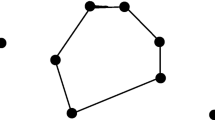Abstract
In this paper a finite element algorithm is presented using a large pre-solved hyper element. Utilizing the largest rectangle/cuboid inside an arbitrary domain, a large hyper element is developed that is solved using graph product rules. This pre-solved hyper element is efficiently inserted into the finite element formulation of partial differential equations (PDE) and engineering problems to reduce the computational complexity and execution time of the solution. A general solution of the large pre-solved element for a uniform mesh of triangular and rectangular elements is formulated for second-order PDEs. The efficiency of the algorithm depends on the relative size of the large element and the domain; however, the method remains as efficient as a classic method for even relatively small sizes. The application of the method is demonstrated using different examples.
Similar content being viewed by others
References
Johnson C.: Numerical Solution of Partial Differential Equations by the Finite Element Method. Courier Corporation, Mineola (2012)
Mitchell A.R., Wait R.: The Finite Element Method in Partial Differential Equations. Wiley, New York (1977)
Babuska I., Tempone R., Zouraris G.E.: Galerkin finite element approximations of stochastic elliptic partial differential equations. SIAM J. Numer. Anal. 42, 800–825 (2004)
Gelinas R., Doss S., Miller K.: The moving finite element method: applications to general partial differential equations with multiple large gradients. J. Comput. Phys. 40, 202–249 (1981)
Gabay D., Mercier B.: A dual algorithm for the solution of nonlinear variational problems via finite element approximation. Comput. Math. Appl. 2, 17–40 (1976)
Oden J.T., Prudhomme S.: Goal-oriented error estimation and adaptivity for the finite element method. Comput. Math. Appl. 41, 735–756 (2001)
Ihlenburg F., Babuška I.: Finite element solution of the Helmholtz equation with high wave number Part I: the h-version of the FEM. Comput. Math. Appl. 30, 9–37 (1995)
Zienkiewicz O.C., Taylor R.L., Zienkiewicz O.C., Taylor R.L.: The Finite Element Method. McGraw-Hill, London (1977)
Strang G., Fix G.J.: An Analysis of the Finite Element Method. Prentice-Hall, Englewood Cliffs (1973)
Hughes T.J.: The Finite Element Method: Linear Static and Dynamic Finite Element Analysis. Courier Corporation, Mineola (2012)
Kaveh A.: Computational Structural Analysis and Finite Element Methods. Springer, Berlin (2014)
Rao S.S.: The Finite Element Method in Engineering: Pergamon International Library of Science, Technology, Engineering and Social Studies. Elsevier, Amsterdam (2013)
Rao S.S.: The Finite Element Method in Engineering. Butterworth-Heinemann, London (2005)
Bathe, K.-J.: Finite Element Procedures. Klaus-Jurgen Bathe, Prentice Hall, Upper Saddle River, 07458 (1996)
Zienkiewicz O., Taylor R., Too J.: Reduced integration technique in general analysis of plates and shells. Int. J. Numer. Methods Eng. 3, 275–290 (1971)
Zienkiewicz O.C., Taylor R.L.: The Finite Element Method: Solid Mechanics. Butterworth–Heinemann, London (2000)
Saad Y.: Iterative Methods for Sparse Linear Systems. SIAM, Philadelphia (2003)
Gibbs N.E., PooleJ. William G., Stockmeyer P.K.: An algorithm for reducing the bandwidth and profile of a sparse matrix. SIAM J. Numer. Anal. 13, 236–250 (1976)
Grote M.J., Huckle T.: Parallel preconditioning with sparse approximate inverses. SIAM J. Sci. Comput. 18, 838–853 (1997)
Evans, D.: The analysis and application of sparse matrix algorithms in the finite element method. In: Whiteman, J.R. (ed.) The Mathematics of Finite Elements and Applications, pp. 427–447. Academic Press, London (1973)
Zingoni A.: A group-theoretic formulation for symmetric finite elements. Finite Elem. Anal. Des. 41, 615–635 (2005)
Kaveh A.: Optimal Structural Analysis. 2nd edn. Wiley, Chichester (2006)
Kaveh A., Shojaei I., Rahami H.: New developments in the optimal analysis of regular and near-regular structures: decomposition, graph products, force method. Acta Mech. 226, 665–681 (2015)
Kaveh A., Rahami H.: An efficient analysis of repetitive structures generated by graph products. Int. J. Numer. Methods Eng. 84, 108–126 (2010)
Shojaei I., Kaveh A., Rahami H.: Analysis of structures convertible to repeated structures using graph products. Comput. Struct. 125, 153–163 (2013)
Kaveh A., Rahami H.: Factorization for efficient solution of eigenproblems of adjacency and Laplacian matrices for graph products. Int. J. Numer. Methods Eng. 75, 58–82 (2008)
Rahami, H., Kaveh, A., Shojaei, I., Gholipour, Y.: Analysis of irregular structures composed of regular and irregular parts using graph products. J. Comput. Civil Eng. 28, 04014016-1–04014016-11 (2014)
Molano R., Rodríguez P.G., Caro A., Durán M.L.: Finding the largest area rectangle of arbitrary orientation in a closed contour. Appl. Math. Comput. 218, 9866–9874 (2012)
Coppersmith, D., Winograd, S.: Matrix multiplication via arithmetic progressions. In: STOC ’87 Proceedings of the Nineteenth Annual ACM Symposium on Theory of Computing, pp. 1–6. ACM, New York (1987)
Williams V.V.: Breaking the Coppersmith–Winograd Barrier. UC Berkeley and Stanford University, USA (2011)
Gall, F.L.: Powers of Tensors and Fast Matrix Multiplication. arXiv:1401.7714 (2014)
Adams M.A., Burton A.K., Dolan P., Bogduk N.: The Biomechanics of Back Pain. Churchill Livingstone, London (2007)
Unnikrishnan G.U., Barest G.D., Berry D.B., Hussein A.I., Morgan E.F.: Effect of specimen-specific anisotropic material properties in quantitative computed tomography-based finite element analysis of the vertebra. J. Biomech. Eng. 135, 101007 (2013)
Shojaei, I., Arjmand, N., Bazrgari, B.: An optimization-based method for prediction of lumbar spine segmental kinematics from the measurements of thorax and pelvic kinematics. Int. J. Numer. Method. Biomed Eng. (2015). doi:10.1002/cnm.2729
Author information
Authors and Affiliations
Corresponding author
Rights and permissions
About this article
Cite this article
Shojaei, I., Kaveh, A. & Rahami, H. An efficient finite element solution using a large pre-solved regular element. Acta Mech 227, 1331–1349 (2016). https://doi.org/10.1007/s00707-015-1552-7
Received:
Revised:
Published:
Issue Date:
DOI: https://doi.org/10.1007/s00707-015-1552-7




